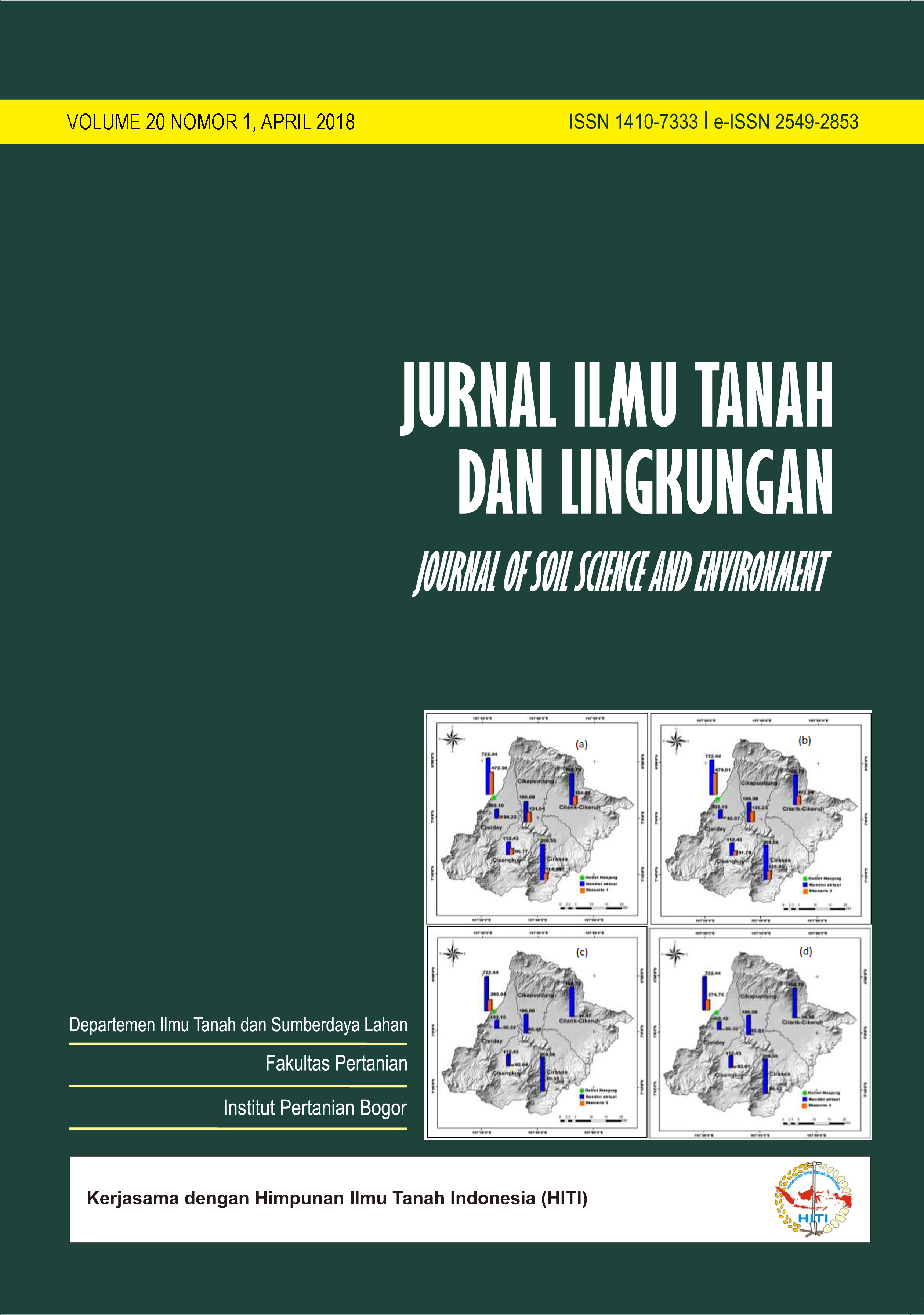Soil Hydrological Characteristics Under Pine (Pinus merkusii), Merawan (Hopea odorata Roxb), and African Mahogany (Khaya anthoteca) Stands
Karakteristik Hidrologi Tanah di Bawah Tegakan Pinus (Pinus merkusii), Merawan (Hopea odorata Roxb) dan Mahoni Uganda (Khaya anthoteca)
Abstract
Forest destruction may affect forest hydrological functions either as a water regulator, maintaining the timing and distribution of river water flows, maintaining microclimate, or being able to protect the underlying areas from disasters such as floods. Revegetation is considered as an effort to improve the condition of forest and environment. The objective of this study was to examine the hydrological characteristics of soil under stands of Pinus (Pinus merkusii), Ugandan Mahogany (Khaya anthoteca), and Merawan (Hopea odorata Roxb). The method used is periodic measurement of soil physical variables. Our investigation reveals that hydrological and physical properties of soil under the stands were different. Within the same depth of soil, water content changed from the highest to the lowest in Pine (3.05%), Merawan Siput Jantan (2.40%), and African Mahogany (1.89%), respectively. The highest infiltration was 116.25 cm hour-1 under Pine stand, while the lowest was 24 cm hour-1 under Merawan Siput Jantan stand. The highest permeability was 13.27 cm hour-1 under Pine stand, while the lowest was 2.72 cm hour-1 under Merawan Siput Jantan stand. Dominated by clay, the soil texture was relatively similar in each stand. Further, the soil under the three stands were categorized as the soil hydrological group B.
Downloads
References
Asdak, C. 1995. Hidrologi dan Pengelolaan Daerah Aliran Sungai. Gadjah Mada University Press., Yogyakarta.
Baskoro, D.P.T. dan S.D. Tarigan. 2007. Soil moisture characteristics on several soil types. Jurnal Tanah dan Lingkungan, 9:77-81.
Baver, L.D., W.H. Gardner and W.R. Gardner. 1972. Soil Physics. Jhon Wiley and Sons Inc., New York.
Departemen Kehutanan. 1994. Kebun Percobaan Dramaga (Edisi Pertama). Badan Penelitian dan Pengembangan Kehutanan, Departemen Kehutanan Indonesia, Jakarta.
Hanafiah, K.A. 2005. Dasar-Dasar Ilmu Tanah. PT Raja Grafindo Persada, Jakarta.
Junaidi, E. dan S.D. Tarigan. 2011. Pengaruh hutan dalam pengaturan tata air dan proses sedimentasi Daerah Aliran Sungai (DAS): Studi Kasus di DAS Cisadane. Jurnal Penelitian Hutan dan Konservasi Alam, 8:155-176.
Kementerian Kehutanan. 2013. Statistik Kehutanan Indonesia 2012. Kementerian Republik Indonesia, Jakarta.
Linsley, R.K. and B.J. Franzini. 1985. Teknik Sumber Daya Air. Erlanga, Jakarta.
Mindawati, N. dan T. Tiryana. 2002. Pertumbuhan Khaya Anthotecha di Jawa Barat. (Growth of Khaya anthotheca in West Java). Buletin Penelitian Hutan, 632:47-58.
Plaster, E.J. 2003. Soil Science and Management 4thEdition. Thomson Learning, New York.
Priyono, N.S. dan S. Sadhardjo. 2002. Hutan pinus dan hasil air. ekstraksi hasil- hasil penelitian tentang hutan pinus terhadap erosi dan tata air. Pusat Pengembangan Sumber Daya Hutan Perhutani, Cepu.
[Puslittanak]. Pusat Penelitian Tanah dan Agroklimat. 1966. Peta Tanah Tinjau Provinsi Jawa Barat. Bogor.
Rahim, S.E. 2003. Pengendalian Erosi Tanah: dalam Rangka Pelestarian Lingkungan Hidup. PT Bumi Aksara, Jakarta.
Sunarti, N. Sinukaban, B. Sanim dan S.D. Tarigan. 2008. Konversi hutan menjadi lahan usahatani karet dan Kelapa Sawit serta pengaruhnya terhadap aliran permukaan dan erosi tanah di DAS Batang Pelepat. Journal of Tropical Soils, 13:253-260.
Tanner, C.B. 1981. Transpiration efficiency of potato. J. Agron., 73:59-64. Doi: 10.2134/agronj1981.00021962007300010014x.
Tarigan, S.D. and S. Widyaliza. 2015. Expansion of oil palm plantations and forest cover changes in Bungo and Merangin Districts, Jambi Province, Indonesia. Procedia Environmental Sciences, 24:199-205
Tarigan, S.D. 2016. Land cover change and its impact on flooding frequency of Batanghari Watershed, Jambi Province, Indonesia. Procedia Environmental Sciences, 33:386-392.
Tarigan, S.D., K. Wiegand, C. Dislich, B. Slamet, J. Heinonen and K. Meyer. 2016. Mitigation options for improving the ecosystem function of water flow regulation in a watershed with rapid expansion of oil palm plantations. Sustainability of Water Quality and Ecology, 8:4-13. http://dx.doi.org/10.1016/j.swaqe.2016.05.001
[USDA] United States Departement od Agriculture. 2009. National Engineering Handbook, Part 630 Hydrology Chapter, Hydrology Soil Groups. United State of Agriculture Natural Resource Conservation Service, Washington DC.
Department of Soil Science and Land Resources Departemen Ilmu Tanah dan Sumberdaya Lahan, Faculty of Agriculture Fakultas Pertanian, IPB University




















